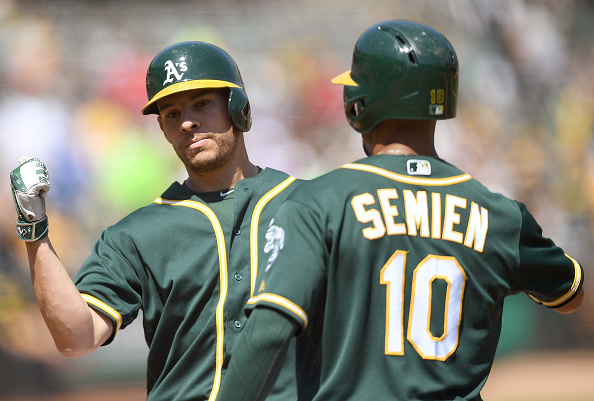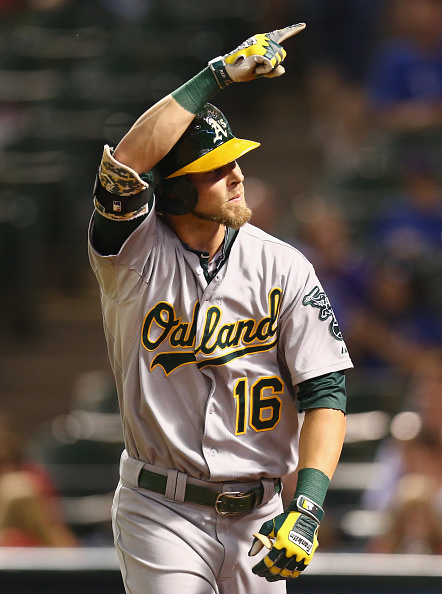The Oakland Athletics weren’t expected to contend for an AL West title or wild card spot in 2016, based mostly on the competition they faced within their division. The Texas Rangers, Houston Astros and Seattle Mariners all looked like potential contenders, while the A’s were building for the future and likely to spin off veteran pieces like Sonny Gray, Rich Hill and Josh Reddick for young talent.
But a starting rotation riddled with injuries prevented the A’s from being any sort of factor in the divisional or wild-card races. Perhaps even more frustrating was that some of those injuries handcuffed executive vice president Billy Beane and general manager David Forst from being able to trade some key pieces that would have yielded both top minor leaguers and major league players that could contribute immediately. That will probably apply in the offseason as well. In the meantime, the A’s will work with what they have — which does include some promising young talent — in hopes of putting this lost season behind them.
Preseason Prediction: That still probably leaves them as a third-place team in their own division. That doesn’t mean they can’t compete for a wild card. It just feels unlikely. If they’re still in the race near the trade deadline, look for Billy Beane to make more trades. But at this point, that might be the worst thing the A’s could do. His recent track record looks pretty ugly. (Derek Harvey, Feb. 29)

OAKLAND, CA – SEPTEMBER 05: Danny Valencia #26 and Marcus Semien #10 of the Oakland Athletics celebrate after Valencia hit a two-run homer against the Los Angeles Angels of Anaheim in the bottom of the first inning at Oakland-Alameda County Coliseum on September 5, 2016 in Oakland, California. (Photo by Thearon W. Henderson/Getty Images)
What Went Right: Perhaps the best thing about the Oakland Athletics’ 2016 season is that the Los Angeles Angels are in the AL West, which might be the only thing preventing them from a last-place finish. Yet even during a season that was expected to be disappointing — in a division with at least three playoff contenders — there were some standouts. Danny Valencia provided a solid bat at third base, though his terrible defense (as -17 Defensive Runs Saved and a -13 Ultimate Zone Rating demonstrate) prompted a move to right field. Marcus Semien has 26 home runs at shortstop (as of Sept. 19). It’s a bit surprising that Valencia wasn’t traded to a team that needed third base help, like the Mets or Indians. (And as it turns out, maybe it would have been a good thing to get Valencia out of that clubhouse, in light of his scuffle with Billy Butler.)
One piece that Beane did trade was pitcher Rich Hill, who managed to stay relatively healthy and as a result had one of his best seasons before being dealt to the Los Angeles Dodgers. In 14 starts, the left-hander went 9-3 with a 2.25 ERA and 90 strikeouts in 76 innings. Unfortunately, he was the only starting pitcher the A’s could depend on this season. Far more reliable was the bullpen. Ryan Madson took over the closer role from Sean Doolittle (who struggled with a shoulder injury), compiling a 3.43 ERA while converting 30 saves in 37 opportunities. Ryan Dull was even more impressive, posting a 2.43 ERA with 66 strikeouts in 69 innings. Though any of them could be traded for prospects, the three relievers are under club control through at least 2018, giving Oakland a strong back end of the bullpen.
What Went Wrong: If the A’s were going to contend for a wild card spot, they needed strong starting pitching. But with the exception of Hill, the rotation was terribly disappointing. Presumed ace (and Beane’s biggest trade chip) Sonny Gray had the worst season of his career, while battling injuries to his shoulder and forearm. Meanwhile, no one else performed like a top-of-the-rotation starter. Jesse Hahn also struggled with shoulder issues, while posting a 6.02 ERA. Chris Bassitt needed Tommy John surgery. And that’s not even including Henderson Alvarez, Felix Doubront and Jarrod Parker, who suffered season-ending injuries before Opening Day.
Kendall Graveman emerged as Oakland’s top starter, based on durability (leading the A’s in starts and innings pitched). He has essentially been the last man standing, staying healthy enough to compile a 10-10 record and 4.21 ERA. Along with Gray, Sean Manaea and Andrew Triggs, Oakland might have the pieces for a solid rotation next season, if injuries can be avoided.
The 2016 A’s season might be most remembered for a clubhouse fight between Danny Valencia and Billy Butler. According to reports, Butler told an equipment representative that Valencia was wearing a different set of shoes during the games than what he was contracted to wear. Valencia confronted Butler about possibly costing him an endorsement deal (which can range between $10,000 and $20,000 for a player) and eventually punched Butler in the head. That resulted in Butler going on the 7-day disabled list with a concussion and his eventual release. Valencia also faced being cut from the roster, but the A’s opted to keep him — at least through the end of the season. Maybe the A’s can base their 2016 season DVD around this. It’s the most interesting thing that happened with this team in 2016.
Most Surprising Player: Actually, any season compilation should be based around the amazing season of Khris Davis. While the A’s surely hoped they would get some right-handed power in left field from a player who showed 30-homer capability with the Milwaukee Brewers, the 28-year-old emerged as one of the top sluggers in the AL, which should continue to keep people mixing him up with the Baltimore Orioles’ Chris Davis. With two home runs against the Texas Rangers on Sept. 18, Davis reached 40 home runs for the season, making him the first Oakland player to reach that total since Jason Giambi hit 43 homers in 2000. Actually, he’s only the fifth player in A’s history to reach the 40-homer mark. Reggie Jackson, Mark McGwire, Jose Canseco, Giambi and… Khris Davis?
Davis’ home run total is even more impressive, considering that O.co Coliseum is the least homer-friendly ballpark in the AL, according to ESPN’s Park Factors. (Only San Francisco’s AT&T Park is more difficult in MLB.) If he had reached that number playing his home games in Milwaukee’s Miller Park, that might have been more plausible. With 13 games left to play as of Sept. 19, Davis and manager Bob Melvin think 45 homers might be within reach. He doesn’t become arbitration-eligible until next season, meaning the A’s have Davis under club control for three more seasons.

ARLINGTON, TX – JULY 26: Sonny Gray #54 of the Oakland Athletics steps off the mound after giving up a homerun against Joey Gallo #13 of the Texas Rangers in the fifth inning at Globe Life Park in Arlington on July 26, 2016 in Arlington, Texas. (Photo by Ronald Martinez/Getty Images)
Most Disappointing Player: Sonny Gray finished third in AL Cy Young Award voting last season, after going 14-7 with a 2.73 ERA and 208 innings pitched. He was one of the best pitchers in the league and figured to yield a potential blockbuster haul of prospects from any team looking for an ace-level starter. It’s possible that Beane would have preferred to keep Gray with four seasons of club control going into this year, the sort of inexpensive, cost-controlled player that a team like the A’s should build around. But Gray could also bring more young talent into the Oakland system, giving Beane more pieces to develop at a lower cost or spin into a veteran acquistion if the team was in contention.
Well, Gray still has a chance to be Beane’s best trade chip with three more seasons of arbitration eligibility. But he didn’t help the A’s much on or off the field this season. Gray had his worst season as a major leaguer, compiling a 5-11 record and a 5.74 ERA that was the highest among starting pitchers with enough innings to qualify for the ERA title. Typical of the Oakland starting rotation in 2016, Gray’s woes were largely due to injury. The right-hander, 28, struggled with a shoulder injury early in the season that required a trip to the disabled list. Then in early August, Gray developed a sore forearm that is often a scary precursor to a more serious elbow injury. Though the A’s didn’t officially shut him down for the rest of the season, it’s a fair guess that the team won’t risk further injury, let Gray get healthy and have a full offseason to recover.
The Future: Going into the 2016 season, minor league analysts ranked the Oakland farm system in the middle of the pack. (ESPN’s Keith Law put them at No. 18.) That’s not terribly encouraging for a team that’s undergoing yet another overhaul, if not an outright rebuild. But Beane did snag three of the Dodgers’ top 10 prospects (according to Baseball Prospectus) in the Rich Hill trade — Frankie Montas, Grant Holmes, and Jharel Cotton — bringing over some young arms that should bolster the Oakland rotation during the next few seasons. Along with Sean Manaea getting promoted to the majors, shortstop Franklin Barreto and third baseman Matt Chapman (both recently promoted to Triple-A), that’s a nice young core of talent to build around and/or ship off for other pieces in the years to come.
For now, however, the A’s have an uphill climb with the Rangers, Houston Astros and Seattle Mariners ahead of them in the AL West. The Rangers are a World Series contender with a relatively young nucleus, the Astros have one of the best young teams in MLB and figure to improve, and the Mariners made significant improvements in the first year under new general manager Jerry Dipoto and field manager Scott Servais. Either of those teams could experience a downturn next season, and if the A’s stay healthy, perhaps they can take advantage. But it’s more likely that Oakland will bide its time and build for the next couple of season, waiting for the opportunity to move back up to the top of the division.

